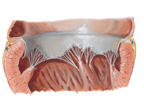Traditional heart surgery to repair faulty valves entails opening the chest cavity and temporarily stopping the heart. The surgery’s invasiveness and high risk factor excludes many patients, such as those with late-stage heart failure or those deemed not sick enough to warrant open-heart surgery, from undergoing the procedure. One common valve condition underserved by open-heart surgery is mitral regurgitation (MR). With MR, changes in the heart prevent the mitral valve from closing properly, causing blood to leak backwards into the left atrium when the valve is closed. If left untreated, MR can lead to arrhythmia, heart failure, and an increased risk of cardiac death. Out of the 250,000 U.S. patients who suffer from MR, less than 20 percent undergo surgery to treat it. A more widely applicable treatment is desperately needed. Luckily, a fast-growing segment of valve repair therapy seems poised to provide less-invasive treatment options for the thousands of MR patients who are left behind.
According to a report in the February 2009 issue of Windhover’s Medtech Insight (available for purchase here), percutaneous mitral therapy offers the potential for valve repair minus the risks associated with open-heart surgery. Scientists hope to eventually perform valve repairs by accessing the vasculature through a small incision in the skin. More than a dozen companies are developing products in this area, which includes such techniques as edge-to-edge leaflet repair, direct annulus remodeling, and coronary sinus annuloplasty.
NeoChord’s device allows doctors to implant an artificial chordae tendinae in a beating heart. Chordae tendinae normally tether the mitral valve leaflets to ensure correct closure during ventricular contraction. Another edge-to-edge leaflet repair device, MitraClip by Evalve, applies polyester-covered metal clips to the leaflets using a catheter-based delivery system.
Other companies are relying on a variety of MR-fighting techniques, many of which are designed to mimic surgical annuloplasty. Mitral Solutions is developing an implantable annuloplasty ring that can be adjusted on a beating heart via the superior pulmonary veins. Medtronic’s technology uses helical anchors and a tether to modify the valve annulus. The MONARC system by Edwards Lifesciences consists of two stent-like anchors and a bridge that are implanted in the coronary sinus. Over time, the biodegradable sutures in the bridge dissolve, shortening the device and creating a sustained tension that improves leaflet function. Mitralign’s percutaneous system delivers implants to the perimeter of the mitral valve. The implants are cinched together to reduce the circumference of the valve opening.
The potential U.S. market for percutaneous mitral valve repair is estimated to be about $2 billion.
Related Video: John Seaberg, President & CEO of Neochord
